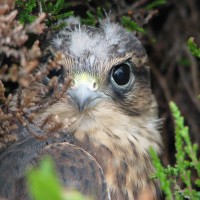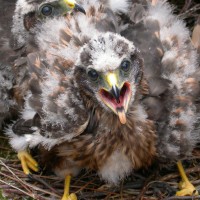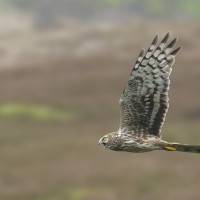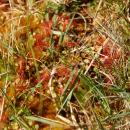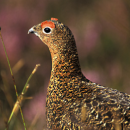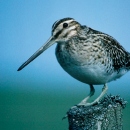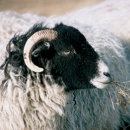- The Moorland Association supported celebrations to mark World Curlew Day this weekend in the North York Moors, with internationally acclaimed singer-songwriter David Gray performing at a special event in aid of curlew conservation. A curlew discovery walk for members of the public took place on Saturday, organised by the charity Curlew Action in partnership with […]
- If you are keen to follow what is being said in the press each day, we suggest you might like to subscribe to this upland newsletter here (after clicking though, scroll down the page and you will see a box near the bottom where you can pop your email address in). This newsletter is prepared […]
- The Moorland Association was approached by The Guardian in advance of a report due to be published by RSPB on 11 April which would show an increasing number of hen harriers in England, but would also refer to illegal killing as a limiting factor. Natural England data, included in the RSPB report, shows a hugely […]
- A Moorland Association member has confirmed that an individual was caught probing peat without consent on a protected site and, if proven, this could amount to a breach of the law. The individual, a volunteer for a not-for-profit organisation, initially claimed that no peat was disturbed and even tried to deny carrying a peat probe. […]
- We are now approaching year seven of the Hen Harrier Brood Management Scheme trial. It stands to reason that, unless Natural England decides to further extend the trial, it will have gathered sufficient information to issue a conservation licence in 2025 – if so, this will be the last year of the trial. By their […]
NE evidence review of cutting
NE evidence review of cutting
NE report on Three wildfires -
NE report on Three wildfires - best practice and lessons learned NE commissioned report based around Winter Hill, Hatfield Moors and Thursley NNR (Surrey) wildfires. Vegetation management/creation of fire breaks recommended – pref mown/cut. Interestingly Thursley NNR had a management plan in place which recognised the need for regular cutting or controlled burns of mature heath, particular in visitor hot spots. Lack of resource had seen this lapse ahead of the wildfire in 2020.
Guidance Checking the peat depth is <40cm prior to undertaking a burn on moorland
This guidance is intended to assist moorland managers who wish to undertake a vegetation burn which they believe does not require a licence under The Heather and Grass etc Burning (England) Regulations 2021, but where there is shallow peat and they wish to collect evidence to show that the peat depth at the location of the burn is 40cm or less. This is not a mandatory process but will help show that reasonable steps have been taken to comply with the regulations. When burning vegetation on peat 40cm or less, you must ensure that all other necessary permissions (e.g. SSSI consent from Natural England) are in place.
GWCT new report: ‘Sustaining ecosystems – English Grouse moors’
At the Upland Workshop, GWCT launched its ‘Sustaining ecosystems – English Grouse moors’ report where an audit and assessment of grouse moor management is undertaken against Government ecosystem service provision

Peak District Wildfire Risk Assessment Report
The first strategic assessment of the wildfire risk for an area of moorland in the UK.
Why our heather moorlands matter
Conserving our moorlands as wondrous spaces for generations to come is vital – yet is fast becoming one of the greatest challenges the UK Countryside is facing
Non-toxic Ammunition Transition
As we know all countryside organisations are signed up to the move away from lead shot and single use plastic in game shooting ammunition by 2025. One year on from that pledge. Click on header to find Joint statement – 1 year lead transition update -a sector update on progress towards this shared goal, including testimony from some key cartridge manufacturers. The timescale is tight and even more so for moorland areas where legislation will be brought forward quickest over peatlands (2023 potentially) but we are encouraged that some members have gone lead-free already. Added to the pressure, key high end retailers that currently take grouse will only accept game shot with lead-free shot from this season coming. To ensure these hard-won retailers continue to sell our premium product we need to assure them of a lead free supply
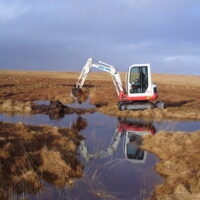
Social barriers and opportunities to the implementation of the England Peatland Strategy
As Defra prepares to announce England’s largest ever peatland restoration scheme as part of its Nature for Climate Fund, new research commissioned by Natural England from Newcastle University has suggested the planned grant scheme needs to ensure that farmers and land managers have the right level of funding and greater control than previous schemes in order to succeed.
What Impacts does Integrated Moorland Management, including Grouse Shooting, have on Moorland Communities? A Comparative Study.
Professor Simon Denny and Tracey Latham-Green of the Institute for Social Innovation and Impact at the University of Northampton have conducted a new study into the economic and social effects of integrated moorland management – including grouse shooting – on moorland communities. The report concluded that grouse shooting forms part of a ‘complex web’ of integrated moorland management practices, with significant economic and social benefits to the people who live in areas associated with these practices.
COVID safe principles for game shoots in England
This document outlines the principles for Covid safe operation of game shoots in England through reference to relevant Government guidance and regulation. It has been produced to assist those managing game shoots to think about and manage the risk posed by COVID-19. It is not exhaustive, and each shoot will need to evaluate its own operations.
The Uplands Partnership: Peatland Protection report
A dossier of new evidence on peatland protection has highlighted a raft of scientific findings that could help shape future conservation of some of the UK’s most iconic landscapes.
UK Trap instructions Jan 2019
Manufacturer’s instructions for setting DOC to catch stoats.

A joint statement on the future of shotgun ammunition for live quarry shooting
The Moorland Association joins other leading shooting and rural organisations who have announced they want an end to the use of lead and single-use plastics in shotgun ammunition for live quarry shooting within five years.

‘Zero Tolerance’ for raptor persecution: A joint statement
The Moorland Association joins other leading rural organisations in issuing a new joint declaration as a clear signal of our intent to end raptor persecution. This calls for the whole shooting community to maintain a ‘zero tolerance’ approach to such crimes and sets out actions that will help achieve this.

VETERINARY MEDICINES FOR GRAZING LIVESTOCK
See link in header for information regarding medicines currently available and used by Graziers on the North York Moors
UMG Risk Assessment Template
The Uplands Management Group was commissioned by Defra to develop this guidance that sets out the requirements for a risk assessment approach to planning and preparing for wildfire incidents and includes a wildfire management plan template and associated guidance. These recommendations include templates that will help landowners and land managers develop a wildfire risk assessment and wildfire plans that will establish good upland management practices to protect people, businesses, land and property, sensitive habitats and the provision of ecosystem (natural) services.

Moorland Association briefing: Fire and the moorland landscape
A briefing from the Moorland Association on fire and the moorland landscape ahead of the publication of the DEFRA review of wildfire in England in December.

Blanket Bog Track Trial - Moor House NNR
A study demonstrating that it is possible to use some vehicles on blanket bog habitats while minimising damage.

Blanket Bog Land Management Guidance - FAQ's
Created by practitioners for practitioners. It explains the current evidence base for peatland restoration and the impacts that different management methods may have, depending on local conditions.

Blanket Bog Land Management Guidance - Outcomes & Improvements
The booklet details the most likely starting points of deep peat you may find on your moor, as described in the Blanket Bog Restoration Strategy. These pages explain how each state of deep peat meets or detracts from the five agreed key outcomes. Actions and examples of restoration scenarios are suggested to move the peatland towards favourable condition.

Blanket Bog Land Management Guidance - Decision Making Toolkit
Use the decision aids in this toolkit on the hill to agree the starting condition of the blanket bog and to decide on best management methods to improve it. The decision aids are intended to aid the thought process when making these decisions, rather than a step-by-step guide to what to do. Use them in conjunction with Blanket Bog: Outcomes and Improvements and Blanket Bog: FAQ to take steps to improve the condition of your blanket bog

Moorland Association submission to Natural England wildfire evidence review, Nov 2016.
The Moorland Association (MA) has answered the eight questions posed by Natural England for this evidence review on wildfire and provided five case studies to illustrate what worked and what did not in mitigating wildfire damage. The MA has drawn 12 observations and conclusions to help the future protection of our precious dry heath and blanket bog from the projected increased threat from wildlife. This threat is now recognised as an urgent climate change risk to natural capital by the Committee for Climate Change Adaption sub-Committee (see page 5.) https://www.theccc.org.uk/wp-content/uploads/2016/07/UK-CCRA-2017-Synthesis-Report-Committee-on-Climate-Change.pdf

Code of Good Shooting Practice
Shooting is under constant and detailed scrutiny and we must demonstrate that we conduct it to high standards. The Code of Good Shooting Practice brings together those standards and makes them easily available to all who participate. It embodies fundamental respect for the quarry species, and care for the environment

Management for red grouse and breeding wader numbers
Lapwing and golden plover are five times more abundant and curlew twice as abundant on moorland managed for red grouse compared to moors with no gamekeepers. RSPB and GWCT research

2008 - 2011 Breeding Merlin Distribution
Of the 10km squares containing breeding Merlin records between 1968 and 2008, around 80% of the records are now located within keepered moorland (Data source: BTO Atlas)
The role of shooting in landscape scale land management
BASC White Paper

Moorland Infrastructure
Natural England's guidance to land managers for applying for consent for butts, scrapes and grit stations.

Peatland Restoration - Landowners rising to the challenge
Poster presentation to the Upland Hydrology Conference in Leeds

The Facts of Rural Life
Charlie Pye-Smith’s new book makes the case for the need for better wildlife management.

Benefits of grouse shooting - infographic
The Moorland Association and British Association for Shooting and Conservation have united to produce this informative infographic on the benefits of grouse shooting.

Stark consequences of no shooting
The British Association for Shooting and Conservation has put together a graphic infogram showing what would happen if there was no shooting. Check out the stark contrasts in Consequences-of-non-shooting BASC infogram

MPs targeted in myth busting mission
TWO leading conservation organisations have united to deliver a series of messages to MPs following flawed and damaging claims about grouse moors and flooding. The British Association for Shooting and Conservation and the Moorland Association have produced Briefing Note - Grouse Moors and Flooding.
Where have all the waders gone?
The tragic loss of lapwing and massive reduction of important waders such as golden plover and curlew are highlighted in a study published in the Welsh Ornithological Society’s journal Birds in Wales.
The study, which cites the loss of driven grouse shooting as being a possible reason behind the declines, together with afforestation, changes in upland farming and climate change, identifies that a reduction in vital moorland management for red grouse has been associated with changes in numbers of upland birds.
PRESS RELEASE
Stark findings in Berwyn
In the 1990s, driven grouse shooting and habitat management stopped in the Berwyn Special Protection Area in North Wales, leading to a serious fall in bird species.
Research into changes in upland bird numbers and distribution between 1983 and 2012 revealed stark findings.
The complete loss of lapwing and serious and rapid declines of many other red listed birds were highlighted. Hen harriers dropped by 48 percent, golden plover by 90 percent, curlew by 79 percent, ring ouzel and black grouse by 78 percent and red grouse by 54 percent.
The Berwyn report demonstrates with great clarity the consequences of losing grouse shooting as a land management tool. The report shows the hugely important work of MA members in their care for 860,000 acres of heather moorland in England and Wales. Without this work, the precious land would revert to scrub and forest and the heather moors lost forever, along with the loss of many red listed birds.
The value of grouse moor management
The Countryside Alliance and National Gamekeepers' Organisation have united to produce this guide on the value of grouse moor management.
Paradoxically, it is due to shooting that the red grouse is not on the endangered species list, and that the numbers of many of the birds which share its habitat during the breeding season are at the high levels that they are. On grouse moors, the management continues whether there is a sufficient surplus of grouse to shoot in a season, or not, and with all the factors that can adversely affect their population, there can be some years when no shooting can take place. The income from shooting is used by landowners to help offset the cost of that management, which benefits not just shooters, but also birdwatchers and all those that love to visit our heather moorlands.
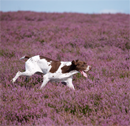
Did You Know?
75% of Europe’s remaining upland heather moorland is found in the UK – but this area declined alarmingly over the latter part of the last century. The Moorland Association was set up in 1986 to coordinate the efforts of moorland owners and managers to halt this loss, particularly in England and Wales.
Stay in Touch with Us
Sign up to our newsletter
WORLD CURLEW DAY CELEBRATIONS ON NORTH YORK MOORS The Moorland Association supported celebrations to mark World Curlew Day this weekend in the North York Moors, with internationally acclaimed singer-songwriter David Gray performing at a special event in aid of curlew conservation. A curlew discovery walk for members of the public took place on Saturday, organised by the charity Curlew Action in partnership with […]
Looking for daily news alerts? If you are keen to follow what is being said in the press each day, we suggest you might like to subscribe to this upland newsletter here (after clicking though, scroll down the page and you will see a box near the bottom where you can pop your email address in). This newsletter is prepared […]




